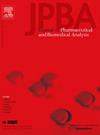氧化应激诱导的布林佐胺降解:独特羟胺和肟降解产物的分离和深入表征
IF 3.1
3区 医学
Q2 CHEMISTRY, ANALYTICAL
Journal of pharmaceutical and biomedical analysis
Pub Date : 2024-09-29
DOI:10.1016/j.jpba.2024.116491
引用次数: 0
摘要
由于治疗产品的安全性和有效性与其稳定性和纯度密切相关,包括不可避免的降解产物在内的杂质可能会影响药理作用。国际人用药品技术要求协调理事会(ICH)指南 Q3A 要求对任何药物中的工艺杂质和降解产物进行鉴定,以评估药物的内在稳定性。本研究在 ICH 指导下对布林佐胺(BRZ)进行了降解研究,布林佐胺是一种眼科外用药物,通常用于降低青光眼患者的眼压(IOP)。在室温下氧化压力作用 20 小时后,利用先进的色谱技术分离出四种降解产物(即 BRZ-Pk1、BRZ-PK2、BRZ-Pk3 和 BRZ-Pk4)。利用高分辨质谱法(HRMS)确认化合物的质量后,再利用傅立叶变换红外光谱法(FT-IR)鉴定官能团。广泛的一维(1D)和二维(2D)核磁共振光谱(NMR)实验,特别是 1D nOe、1H-13C-HSQC 和 1H-13C-HMBC,明确证实了化合物的结构。在分析的四种化合物中,有三种(BRZ-Pk1、BRZ-Pk2 和 BRZ-Pk4)是新发现的,而 BRZ-Pk3 以前仅通过质谱数据进行过报道。氮基二维核磁共振实验对于确定分子中羟胺和肟产物的氧化态至关重要,而一维 nOe 测量有助于确认 BRZ-Pk2 和 BRZ-Pk4 的 E/Z 异构体(几何异构)。所有提出的结构都有适当的分析数据作为依据。预计所提出的机理将有助于确定类似候选药物的可能降解途径。本文章由计算机程序翻译,如有差异,请以英文原文为准。
Oxidative stress-induced degradation of Brinzolamide: Isolation and in-depth characterization of unique hydroxylamine and oxime degradation products
Since the safety and efficacy of therapeutic products are strongly related to their stability and purity, impurities including the unavoidable degradation products may affect the pharmacological effect. The International Council for Harmonisation of Technical Requirements for Pharmaceuticals for Human Use (ICH) guidelines Q3A requires the identification of process impurities and as well as degradation products in any drug substance to assess the inherent stability of the drug. The present work involves an ICH-guided degradation study for the Brinzolamide (BRZ), a topical ophthalmic drug which is generally used to lower the intraocular pressure (IOP) during glaucoma. Under oxidative stress at room temperature for 20 h, four degradation products (namely BRZ-Pk1, BRZ-PK2, BRZ-Pk3, and BRZ-Pk4) are isolated using advanced chromatographic techniques. Upon confirming the masses of the compounds using High-resolution mass spectrometry (HRMS), functional groups are identified with the help of Fourier-transform infrared spectroscopy (FT-IR). Extensive 1-dimensional (1D) and 2-dimensional (2D) Nuclear Magnetic Resonance spectroscopic (NMR) experiments especially 1D nOe, 1H-13C-HSQC and 1H-13C-HMBC unequivocally confirm the structures. Among the four compounds analyzed, three (BRZ-Pk1, BRZ-Pk2, and BRZ-Pk4) are novel, while BRZ-Pk3 was previously reported solely with mass spectrometric data. Nitrogen-based 2D NMR experiments are crucial for determining the oxidation state of hydroxylamine and oxime products within the molecules, and 1D nOe measurements help confirming E/Z isomerism (geometrical isomerism) for BRZ-Pk2 and BRZ-Pk4. All the proposed structures are justified with appropriate analytical data. The proposed mechanisms are expected to help in identifying the possible degradation pathways for similar pharmaceutical candidates.
求助全文
通过发布文献求助,成功后即可免费获取论文全文。
去求助
来源期刊
CiteScore
6.70
自引率
5.90%
发文量
588
审稿时长
37 days
期刊介绍:
This journal is an international medium directed towards the needs of academic, clinical, government and industrial analysis by publishing original research reports and critical reviews on pharmaceutical and biomedical analysis. It covers the interdisciplinary aspects of analysis in the pharmaceutical, biomedical and clinical sciences, including developments in analytical methodology, instrumentation, computation and interpretation. Submissions on novel applications focusing on drug purity and stability studies, pharmacokinetics, therapeutic monitoring, metabolic profiling; drug-related aspects of analytical biochemistry and forensic toxicology; quality assurance in the pharmaceutical industry are also welcome.
Studies from areas of well established and poorly selective methods, such as UV-VIS spectrophotometry (including derivative and multi-wavelength measurements), basic electroanalytical (potentiometric, polarographic and voltammetric) methods, fluorimetry, flow-injection analysis, etc. are accepted for publication in exceptional cases only, if a unique and substantial advantage over presently known systems is demonstrated. The same applies to the assay of simple drug formulations by any kind of methods and the determination of drugs in biological samples based merely on spiked samples. Drug purity/stability studies should contain information on the structure elucidation of the impurities/degradants.

 求助内容:
求助内容: 应助结果提醒方式:
应助结果提醒方式:


